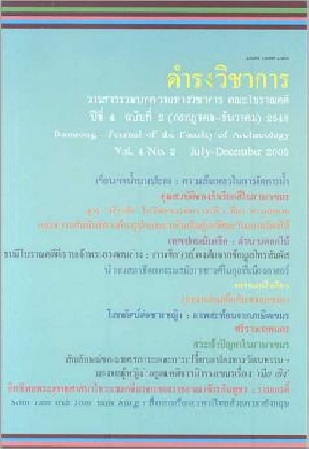MUGHAL ARCHITECTURE AT LAHORE
Keywords:
สถาปัตยกรรม, ราชวงศ์โมกุล, เมืองลาฮอร์Abstract
Lahore, nowadays in Pakistan, was one of the most significant cities during the reigns of Mughal emperors who controlled the Indian subcontinent in 16th -17th centuries A.D. during this epoch , because of royal patronage, a large number of palaces, mosques and gardens had been built throughout city. The royal palaces of Lahore , or Shahi Qila, composed of the red- sand stone public throne hall and the white-marbled privates throne hall beautified with inlay motifs, represent the tradition of Mughal comparable to those of Delhi and Agra. Shalimar garden, one of the two existing gardens bearing the same name in Indian subcontinent , is also one of the royal architecture s in which the garden is incorporated. The garden comprises an elongated waterway alternated with throne halls, pools and fountains. The splendor of the garden inspired by the Koranic version of the garden of the Eden. Amongst the spectacular mosques dotted around the city , Wazir Khan Masjid and Badshahi Masjid are the most significant. The former, constructed during the reign of Shah Jahan , is prestigious for it marvelous decorations . It is composed of foliage motifs tiles of the façade and embellished mural painting inside. Two style of Murqanas have been shown simultaneously , i.e. the typical Mughal one and Persian styles, the latter, famous for its grandness , is said to be one of the loftiest mosques during the Mughal regime . The motifs which decorate the gateway and the prayer hall indicate the influx of the Western influences during Aurangzeb’s reign. Beside palaces and mosques , royal tomb in Lahore are also interesting Inasmuch as Jahangir’s tomb comprised only the wide-spread base and minarets this is one of the most peculiar examples of the architecture in the Indian subcontinent, indicating the orthodox Islamic belief which says one’s grave should be exposed to the open-sky. The nearby Asif khan’s tomb , previously ornamented with yellow tiles , is unfortunately in ruin after it was destroyed by the troop of Ranjit Singh , an emperor of the later Sikh Empire.
References
Barrucand, M. "The Garden as a Reflection of Paradise", Islam : Art and ArchItecture. France : Konemann, 2000.
Chaudhry, N.A. A Short History of Lahore and some of its Monuments. Lahore : Sang-e-Meel Publications, 2000.
Kamiya, T. The Guide to the Architecture of the Indian Subcontinent. Hyderabad : Pragati Art Printer, 1996.
Koch, E. Mughal Architecture. New Delhi : Oxford University Press, 2002.
Raza, M.H. Lahore : Past and Present. Islamabad : Barqson Printers, 1987.
Vaughan, P. "Indian Subcontinent : From the Sultanate to Mughal Empire", Islam : Art and Architecture. France : Konemann, 2000.
Downloads
Issue
Section
License
บทความนี้เป็นผลงานของข้าพเจ้าแต่เพียงผู้เดียว และ/หรือเป็นผลงานของข้าพเจ้าและผู้ร่วมงาน ตามชื่อที่ระบุในบทความจริง และเป็นผลงานที่มิได้ถูกนำเสนอหรือตีพิมพ์ที่ใดมาก่อน


